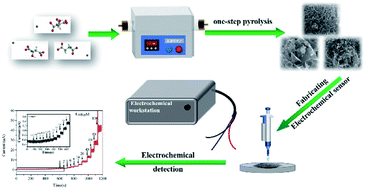Three-dimensional porous carbon derived from different organic acid salts for application in electrochemical sensing†
Abstract
Three-dimensional porous carbon materials were synthesized by the one-step pyrolysis of organic salts with different numbers of hydroxyl groups on the side chain (sodium tartrate, sodium malate and sodium succinate). Further, the formation of these porous carbon materials was explored. And then, three kinds of carbon materials were used for constructing electrochemical sensors for nitrite detection, respectively. Porous carbon derived from sodium tartrate (PCST) showed the highest electrocatalytic ability for nitrite oxidation among all three materials. The PCST-based sensors allow for rapid detection of nitrite in a wide linear range of 0.1–100 μM with a low detection limit of 0.043 μM. The sensor was applied to detect nitrite in meat samples and the results tested by the developed sensor were consistent with the results obtained by HPLC. We envision that PCST-based electrochemical sensor is promising as an alternative choice for the development of electrochemical analysis.



 Please wait while we load your content...
Please wait while we load your content...